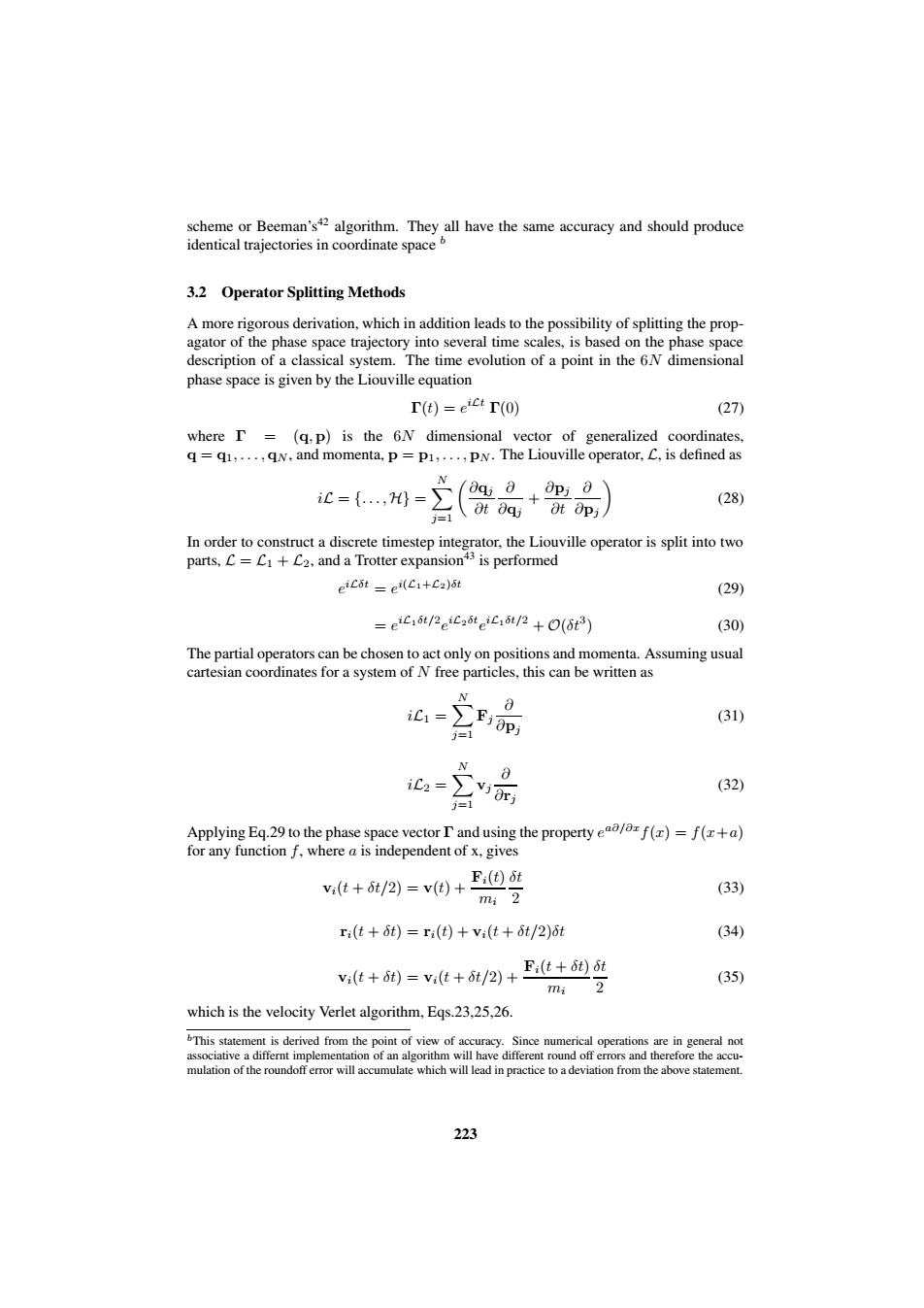正在加载图片...

scheme or Beeman's42 algorithm.They all have the same accuracy and should produce identical trajectories in coordinate space 3.2 Operator Splitting Methods A more rigorous derivation,which in addition leads to the possibility of splitting the prop- agator of the phase space trajectory into several time scales,is based on the phase space description of a classical system.The time evolution of a point in the 6N dimensional phase space is given by the Liouville equation I(t)=eictr(0) (27) where I (q,p)is the 6N dimensional vector of generalized coordinates. q=q1,...,qN,and momenta,p=p1,...,pN.The Liouville operator,C,is defined as N iC={..,H}=】 (日+ Opj a t∂ai at Op. (28) =1 In order to construct a discrete timestep integrator,the Liouville operator is split into two parts,C=C1+C2,and a Trotter expansion3 is performed eiLot =ei(C1+Ca)ot (29) =eicibtp2eicaoteici8t/2+O(6t3) (30) The partial operators can be chosen to act only on positions and momenta.Assuming usual cartesian coordinates for a system of N free particles,this can be written as N iC1=∑Fp (31) N iC2=∑vm (32) j=1 Applying Eq.29 to the phase space vector I and using the property ea/arf(x)=f(+a) for any function f,where a is independent of x,gives v(t+6t/2)=v(t)+ Fi(t)6t mi 2 (33) r(t+t)=r(t)+v(t+6t/2)6t (34) vt+0)=vt+t/2+Et+的t (35) m12 which is the velocity Verlet algorithm,Eqs.23,25,26. bThis statement is derived from the point of view of accuracy.Since numerical operations are in general not associative a differnt implementation of an algorithm will have different round off errors and therefore the accu- mulation of the roundoff error will accumulate which will lead in practice to a deviation from the above statement. 223scheme or Beeman’s 42 algorithm. They all have the same accuracy and should produce identical trajectories in coordinate space b 3.2 Operator Splitting Methods A more rigorous derivation, which in addition leads to the possibility of splitting the propagator of the phase space trajectory into several time scales, is based on the phase space description of a classical system. The time evolution of a point in the 6N dimensional phase space is given by the Liouville equation Γ(t) = e iLt Γ(0) (27) where Γ = (q, p) is the 6N dimensional vector of generalized coordinates, q = q1, . . . , qN , and momenta, p = p1, . . . , pN . The Liouville operator, L, is defined as iL = {. . . , H} = X N j=1 ∂qj ∂t ∂ ∂qj + ∂pj ∂t ∂ ∂pj (28) In order to construct a discrete timestep integrator, the Liouville operator is split into two parts, L = L1 + L2, and a Trotter expansion43 is performed e iLδt = e i(L1+L2)δt (29) = e iL1δt/2 e iL2δt e iL1δt/2 + O(δt 3 ) (30) The partial operators can be chosen to act only on positions and momenta. Assuming usual cartesian coordinates for a system of N free particles, this can be written as iL1 = X N j=1 Fj ∂ ∂pj (31) iL2 = X N j=1 vj ∂ ∂rj (32) Applying Eq.29 to the phase space vector Γ and using the property e a∂/∂xf(x) = f(x+a) for any function f, where a is independent of x, gives vi(t + δt/2) = v(t) + Fi(t) mi δt 2 (33) ri(t + δt) = ri(t) + vi(t + δt/2)δt (34) vi(t + δt) = vi(t + δt/2) + Fi(t + δt) mi δt 2 (35) which is the velocity Verlet algorithm, Eqs.23,25,26. bThis statement is derived from the point of view of accuracy. Since numerical operations are in general not associative a differnt implementation of an algorithm will have different round off errors and therefore the accumulation of the roundoff error will accumulate which will lead in practice to a deviation from the above statement. 223